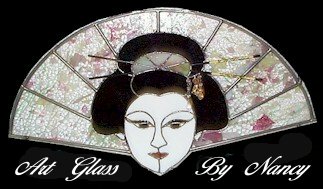


A Little History On Glass
Continued
Tiffany began adding various metallic oxides to the basic glass formula to get the effects that he wanted. His goal was realized when, in 1893, the new firm of Tiffany and Company offered for sale objects of “Favrile” glass. This word became his trademark. Taken from the Latin word “Faber” meaning “smith”, that is, hand crafted, it soon brought it into worldwide renown.
The strength of color and variety of “form” finally achieved on Favrile glass is still unequaled. Tiffany used his glass not only in three dimensional pieces such as vases and lamps, but he also used it in windows, along with rocks, seashells, pebbles and anything else that would give the effect he wanted. Graceful designs characterized his work, and because of the nature of the small pieced undulating break lines, he used (probably devised) a method of holding his glass together with copper foil as well as with lead. This more supple material could take the multiple tiers of his fenestration without giving the bulky, staggered look that lead would of necessity present.
It provided an equally natural adaptation to the three dimensional form, for each piece of glass, wrapped in its edging of copper foil, could be easily made to conform to a molded surface and then soldered together to completion. Making such designs of small pieces of glass held together with copper foil and involving extreme technical skill has become known as the “Tiffany Foil Method.”
There was a continuing development in stained glass as it is known today and resurgence in the seventies and nineties and now again stained glass is quite popular.
So we have in this brief period, skipped over centuries of the History of the Art of Colored Glass.
Its current position as a rapidly growing hobby for the crafts enthusiast, as well as its role in specific productions by artist of renown, have given it a permanent status among the creative media and is now fighting for renown in the Art World.
This is a smattering but a basic history in stained glass but the library, book stores, or glass suppliers, are an excellent source for more information.
The strength of color and variety of “form” finally achieved on Favrile glass is still unequaled. Tiffany used his glass not only in three dimensional pieces such as vases and lamps, but he also used it in windows, along with rocks, seashells, pebbles and anything else that would give the effect he wanted. Graceful designs characterized his work, and because of the nature of the small pieced undulating break lines, he used (probably devised) a method of holding his glass together with copper foil as well as with lead. This more supple material could take the multiple tiers of his fenestration without giving the bulky, staggered look that lead would of necessity present.
It provided an equally natural adaptation to the three dimensional form, for each piece of glass, wrapped in its edging of copper foil, could be easily made to conform to a molded surface and then soldered together to completion. Making such designs of small pieces of glass held together with copper foil and involving extreme technical skill has become known as the “Tiffany Foil Method.”
There was a continuing development in stained glass as it is known today and resurgence in the seventies and nineties and now again stained glass is quite popular.
So we have in this brief period, skipped over centuries of the History of the Art of Colored Glass.
Its current position as a rapidly growing hobby for the crafts enthusiast, as well as its role in specific productions by artist of renown, have given it a permanent status among the creative media and is now fighting for renown in the Art World.
This is a smattering but a basic history in stained glass but the library, book stores, or glass suppliers, are an excellent source for more information.
